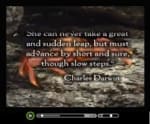Origin Of Life
Origin of Life - Spontaneous Generation
For millennia, the Origin of Life was thought to be the result of Abiogenesis (also known as "Spontaneous Generation"). The doctrine of Spontaneous Generation holds that organic life could and does arise from inorganic matter. As late as the 17th century, there were recipes to "create" life. Take sweaty rags, wrap them around wheat, and set them in an open jar. In 21 days, you'll "create" mice. For rats, just throw garbage in the street. In a few days, rats will take the place of the garbage. All over the world, in Europe, Asia, Africa and the Americas, mankind was formulating recipes for "creating" bees, lice, scorpions, maggots, worms, frogs, etc. In 1668, Francesco Redi publicly opposed the idea of Spontaneous Generation. While it was generally accepted that rotting meat generated maggots, Redi disagreed. He maintained that maggots hatched from eggs laid by flies. To test his hypothesis, Redi performed one of the first known experiments to utilize a "control group." Thus began both the death of Spontaneous Generation and the birth of the modern era of scientific development. Redi placed meat in three flasks -- one open, one sealed and one covered with gauze. Maggots appeared in the open flask, as the flies were able to reach the meat. Maggots did not appear in the sealed flask or the flask covered by gauze. At the time, this experiment was not thought to disprove Spontaneous Generation. It merely proved that maggots did not come from meat.
Origin of Life - Louis Pasteur
Spontaneous Generation was thought to be the Origin of Life until the late 1850's. It wasn't until Frenchman Louis Pasteur that this fallacy was finally disproved. In 1859, the French Academy of Science sponsored a Science Fair, the goal being to prove or disprove Spontaneous Generation. Young Pasteur's award winning experiment was a clever variation of earlier experiments performed by John Needham (1713-1781) and Lazzaro Spallanzani (1729-1799). Pasteur filled a long necked flask with meat broth. He then heated the glass neck and bent it into an "S" shape. Air could reach the broth, but gravity acted to trap airborne microorganisms in the curve of the neck. He then boiled the broth. After a time, no microorganisms had formed in the broth. When the flask was tipped so that the broth reached the microorganisms trapped in the neck, the broth quickly became cloudy with microscopic life. Thus, Pasteur disproved Spontaneous Generation. Furthermore, Pasteur proved that some microorganisms are airborne.
Origin of Life - Origin of Species and Modern Day Science Class
Spontaneous Generation was disproved as the Origin of Life in 1859. Ironically, it was this same year that Charles Darwin's Origin of Species was published. From this work arose the modern evolutionary movement, which is now thought to have occurred in six phases: (1) Cosmic Evolution (the origin of space, time, matter and energy from nothing); (2) Chemical Evolution (the development of the higher elements from hydrogen); (3) Stellar and Planetary Evolution (the origin of stars and planets); (4) Organic Evolution (the origin of organic life from a rock); (5) Macro Evolution (the origin of major kinds); and (6) Micro Evolution (the variation within the kinds). Only the sixth phase has been observed and documented. The first five are merely assumed. Interestingly, the fourth assumption is the old doctrine of Spontaneous Generation - organic life developing from inorganic matter (a rock). The sadly comical result is that some modern day textbooks devote a chapter to the work of Francesco Redi and Louis Pasteur, and their success in disproving Spontaneous Generation. Then, a few chapters later, school kids are taught that Spontaneous Generation is the Origin of Life.

